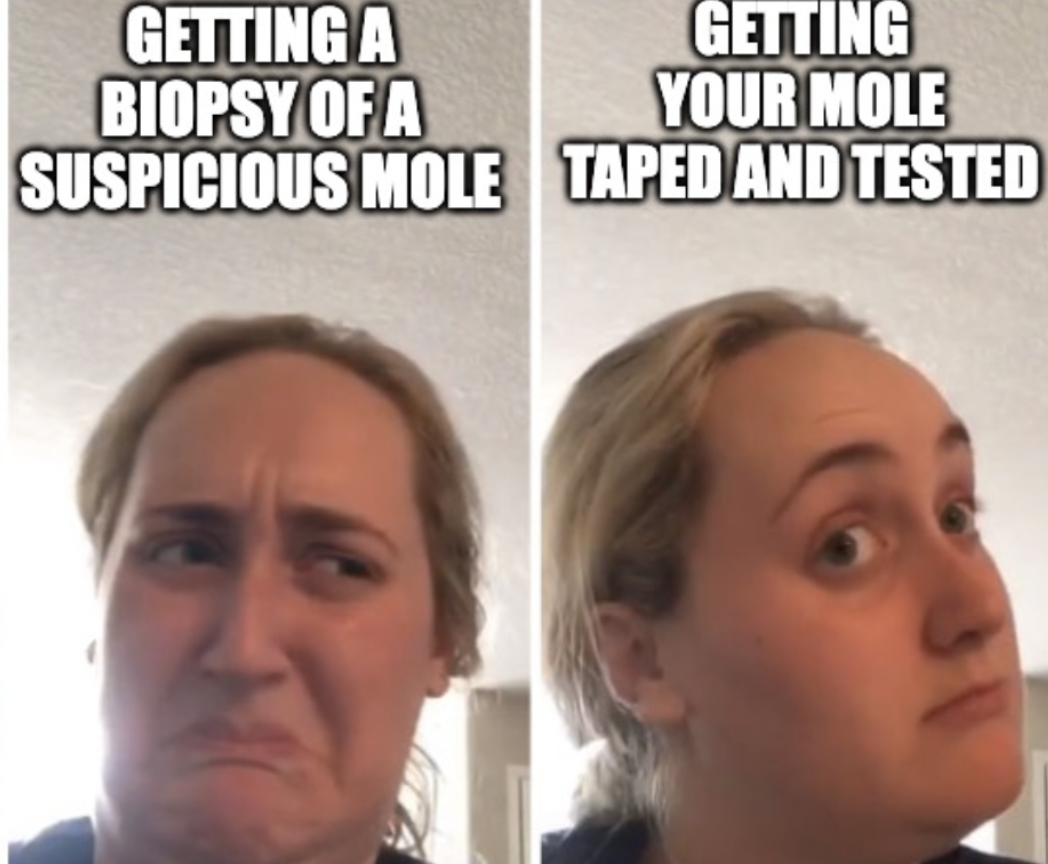Forty-second ISSUE
September 6, 2023
Could differences in the gut microbiome in patients with melanoma be a target for future therapy?
JAMA Dermatology
JAMA Dermatology
Sometimes it’s just a GUT feeling…
The gut microbiome both plays a role as an immune mediator and impacts the body’s response to immunotherapy. Researchers were curious if there were differences in the gut microbiomes of healthy individuals versus those with early or late-stage melanoma.
This single-center case-control study sought to compare the microbiota of these different populations using fecal samples from 228 participants (healthy patients and treatment naive with stage I-IV melanoma). After ribosomal RNA sequencing was complete, microbiome diversity, taxonomic and functional profiles were compared between groups.
What did they find?
Main Takeaway: Gut dysbiosis may be a future target for systemic treatment of melanoma, but further prospective studies are needed to validate these findings.
The gut microbiome both plays a role as an immune mediator and impacts the body’s response to immunotherapy. Researchers were curious if there were differences in the gut microbiomes of healthy individuals versus those with early or late-stage melanoma.
This single-center case-control study sought to compare the microbiota of these different populations using fecal samples from 228 participants (healthy patients and treatment naive with stage I-IV melanoma). After ribosomal RNA sequencing was complete, microbiome diversity, taxonomic and functional profiles were compared between groups.
What did they find?
- Microbiomes differed drastically between patients with melanoma versus controls
- After comparing microbiomes of early versus late stage melanoma:
- Early-stage melanomas varied more within individual samples (p = .003), and contained more Roseburia on univariate analysis compared to late-stage melanoma (2.4% vs 1.2%; p < .001)
- Statistical significance was lost with covariate adjustment (p = 0.13)
- Melanoma samples contained higher amounts of Fusobacterium compared to healthy patients (0.19% vs 0.003%; P<0.001)
- No associations were observed between the microbiota taxa and rates of disease recurrence in patients with Stage III melanoma being treated with adjuvant immunotherapy
Main Takeaway: Gut dysbiosis may be a future target for systemic treatment of melanoma, but further prospective studies are needed to validate these findings.
UV-B phototherapy does not increase the risk of skin cancer among patients with atopic dermatitis
Journal of the American Academy of Dermatology
Journal of the American Academy of Dermatology
There really is light at the end of the tunnel!!
Atopic dermatitis (AD) is the most common inflammatory skin disease worldwide, impacting up to 20% of children and 5% of adults. UV-B phototherapy is a treatment option for patients with atopic dermatitis due to its lack of systemic toxicity or drug interactions, safety for patients with malignancy or tuberculosis, and affordability. Chronic UV exposure is a well-established risk factor for skin cancer, raising concerns regarding the long-term safety of UV-B phototherapy.
This retrospective, population-based cohort study (n = 6205) sought to evaluate the risk of skin cancer in patients with AD treated with UV-B phototherapy. The primary outcomes of the study were the incidence of nonmelanoma skin cancer (NMSC) and cutaneous melanoma.
What did they find?
Main Takeaway: UV-B phototherapy does not increase the risk of NMSC or cutaneous melanoma among patients with AD.
Atopic dermatitis (AD) is the most common inflammatory skin disease worldwide, impacting up to 20% of children and 5% of adults. UV-B phototherapy is a treatment option for patients with atopic dermatitis due to its lack of systemic toxicity or drug interactions, safety for patients with malignancy or tuberculosis, and affordability. Chronic UV exposure is a well-established risk factor for skin cancer, raising concerns regarding the long-term safety of UV-B phototherapy.
This retrospective, population-based cohort study (n = 6205) sought to evaluate the risk of skin cancer in patients with AD treated with UV-B phototherapy. The primary outcomes of the study were the incidence of nonmelanoma skin cancer (NMSC) and cutaneous melanoma.
What did they find?
- UV-B phototherapy treatment was not associated with an increased risk of skin cancer (HR: 0.91; 95% CI: 0.35-2.35), nor was the risk of skin cancer associated with the number of UV-B phototherapy sessions (HR: 0.99; 95% CI: 0.96-1.02)
- Neither UV-B phototherapy treatment (HR: 0.80; 95% CI: 0.29-2.26) nor the number of UV-B phototherapy sessions increased the risk of NMSC (HR: 0.99; 95% CI: 0.96-1.03)
- The risk of melanoma did not increase with UV-B phototherapy treatment (HR: 0.80; 95% CI: 0.08-7.64) or the number of UV-B phototherapy sessions (HR: 0.94; 95% CI: 0.77-1.15)
Main Takeaway: UV-B phototherapy does not increase the risk of NMSC or cutaneous melanoma among patients with AD.
Can biologics be used to safely treat atopic dermatitis in children and adolescents?
Pediatric Dermatology
Pediatric Dermatology
Why did the eczema patient become a fan of dupilumab? Because it helped them "dupilu-manage" their skin condition!
Atopic dermatitis (AD) is a chronic inflammatory condition causing dry, itchy skin that affects 20% of children and 16% of adolescents in the U.S. In patients with moderate-to-severe AD, first-line treatment has traditionally involved systemic treatments like corticosteroids and immunosuppressive drugs, and more recently, targeted biological agents have been introduced.
Although previous reviews have examined dupilumab's use in adults with AD, its application in pediatric AD remains unexplored. Researchers conducted a systematic review of 7 clinical trials and 11 observational studies to assess the safety and efficacy of dupilumab, a human monoclonal antibody, in 1275 pediatric patients aged 6 months to 17 years.
What did they find?
Main Takeaways: This study revealed that dupilumab has an acceptable safety profile and long-term efficacy in the treatment of pediatric patients with moderate-to-severe AD.
Atopic dermatitis (AD) is a chronic inflammatory condition causing dry, itchy skin that affects 20% of children and 16% of adolescents in the U.S. In patients with moderate-to-severe AD, first-line treatment has traditionally involved systemic treatments like corticosteroids and immunosuppressive drugs, and more recently, targeted biological agents have been introduced.
Although previous reviews have examined dupilumab's use in adults with AD, its application in pediatric AD remains unexplored. Researchers conducted a systematic review of 7 clinical trials and 11 observational studies to assess the safety and efficacy of dupilumab, a human monoclonal antibody, in 1275 pediatric patients aged 6 months to 17 years.
What did they find?
- Efficacy was assessed by the number of patients who achieved a reduction in eczema area and severity index (EASI) of at least 50% (EASI 50, 72.9% of overall pediatric patients), 75% (EASI 75, 57.4%), 90% (EASI 90, 31.3%), or 100% (EASI 100, 29.7%)
- With longer treatment duration, patients were found to have a higher rate of achieving EASI 75 (26.8% of patients achieved EASI 75 after 2-8 weeks, 57.8% after 12-24 weeks, and 84.9% after 32-52 weeks of treatment)
- More adolescents (ages 12-17 years) achieved EASI 75 compared to children (ages 6 months to 11 years) (70.0% vs 52.6%, p = 0.118)
- The most common adverse events among pediatric patients treated with dupilumab were comparable to those among adults, including conjunctivitis (6.6% in children vs 8.0% in adults), nasopharyngitis (10.6% vs. 15.7%), upper respiratory tract infection (10.1% vs. 6.6%), and headache (7.5% vs. 7.6%)
Main Takeaways: This study revealed that dupilumab has an acceptable safety profile and long-term efficacy in the treatment of pediatric patients with moderate-to-severe AD.
Altered Notch signaling in Dowling-Degos disease: A transcriptomic insight into disease pathogenesis
British Journal of Dermatology
British Journal of Dermatology
Genetics… top Notch stuff.
Dowling Degos disease is an autosomal dominant pigment disorder characterized by progressive brown-black hyperpigmented macules and papules primarily in flexural surfaces. Loss of function mutations in KRT5, POFUT1, POGLUT1, PSENEN have been associated with the disease. Most of these genes encode proteins involved in Notch signaling, a pathway essential for human development. Researchers sought to investigate how Notch signaling is affected in Dowling-Degos. By knocking down genes associated with Dowling Degos, POGLUT1/PSENEN, they examined how gene transcription is affected using RNA sequencing.
What did they find?
Main takeaway: Notch signaling likely plays a role in the pathogenesis of Dowling Degos disease.
Dowling Degos disease is an autosomal dominant pigment disorder characterized by progressive brown-black hyperpigmented macules and papules primarily in flexural surfaces. Loss of function mutations in KRT5, POFUT1, POGLUT1, PSENEN have been associated with the disease. Most of these genes encode proteins involved in Notch signaling, a pathway essential for human development. Researchers sought to investigate how Notch signaling is affected in Dowling-Degos. By knocking down genes associated with Dowling Degos, POGLUT1/PSENEN, they examined how gene transcription is affected using RNA sequencing.
What did they find?
- After knocking down POGLUT1 and PSENEN, the Notch signaling pathway was the most commonly affected
- Additional pathways affected include membrane trafficking, receptor tyrosine kinase signaling, and estrogen receptor mediated signaling
- Researchers confirmed functional changes in Notch signaling in melanocyte cell culture assays. Interestingly, these changes in Notch signaling are not observed in some other cell lines lacking POFUT1 expression
Main takeaway: Notch signaling likely plays a role in the pathogenesis of Dowling Degos disease.
Patients may be able to avoid unnecessary surgery and biopsies of suspicious lesions with a new tape stripping RNA sequencing method
Journal of the American Academy of Dermatology
Journal of the American Academy of Dermatology
RNA Sequencing: Taping and shaping melanoma management
Cutaneous malignant melanoma (CMM) may be difficult to distinguish from benign melanocytic nevi; many physicians rely on dermatopathology results for such challenging lesions. Currently, the number needed to biopsy ranges from 8-20 per one CMM diagnosed, depending on one’s dermoscopy experience.
To prevent “over removal” of suspicious lesions and spare patients unnecessary biopsy, it may be judicious to consider alternate diagnostic techniques. Tape stripping is a technique that allows cells from the superficial stratum corneum to be collected and undergo RNA sequencing.
What did they find?
Main Takeaway: RNA sequencing after tape stripping of suspicious lesions may provide a noninvasive technique to identify cutaneous malignant melanoma and avoid unnecessary biopsy in patients with benign lesions.
Cutaneous malignant melanoma (CMM) may be difficult to distinguish from benign melanocytic nevi; many physicians rely on dermatopathology results for such challenging lesions. Currently, the number needed to biopsy ranges from 8-20 per one CMM diagnosed, depending on one’s dermoscopy experience.
To prevent “over removal” of suspicious lesions and spare patients unnecessary biopsy, it may be judicious to consider alternate diagnostic techniques. Tape stripping is a technique that allows cells from the superficial stratum corneum to be collected and undergo RNA sequencing.
What did they find?
- 200 lesions identified
- Tape stripping performed first, samples evaluated for expression of PRAME and KIT oncogenes
- Lesions later biopsied, histopathology confirmed 73 CMMs
- Tape stripping performed first, samples evaluated for expression of PRAME and KIT oncogenes
- There was a significant positive correlation between the lesion surface area (p<0.0005), patient’s age (p<0.0005), and storage time when greater than 14 days, and gene expression level between all measured genes except PRAME and KIT
- The tape strip identified CMMs expressing PRAME and KIT with 100% sensitivity and 32% specificity
Main Takeaway: RNA sequencing after tape stripping of suspicious lesions may provide a noninvasive technique to identify cutaneous malignant melanoma and avoid unnecessary biopsy in patients with benign lesions.
Prevalence of Atopic Diseases Among Sexually Diverse Adults in the US
Atopic diseases share genetic and environmental risk factors. Prior studies found that sexually diverse (SD) patients experience higher rates of asthma and allergic rhinitis compared to heterosexual individuals. We were curious if there is an association between prevalence of atopic diseases and sexual orientation.
We performed a cross-sectional study using data from the 2021 National Health Interview Survey. Multivariable-adjusted odd ratios (aOR) were calculated utilizing logistic regression for current prevalence of atopic diseases.
What did we find?
Main Takeaway: The prevalence of atopic diseases is higher among SD patients compared to heterosexual adults. Future studies need to determine which underlying factors contribute to these differences.
Atopic diseases share genetic and environmental risk factors. Prior studies found that sexually diverse (SD) patients experience higher rates of asthma and allergic rhinitis compared to heterosexual individuals. We were curious if there is an association between prevalence of atopic diseases and sexual orientation.
We performed a cross-sectional study using data from the 2021 National Health Interview Survey. Multivariable-adjusted odd ratios (aOR) were calculated utilizing logistic regression for current prevalence of atopic diseases.
What did we find?
- SD patients (n=1,311) compared with heterosexual patients (n=25,701) reported higher prevalence of:
- atopic dermatitis (11.1% vs 7.2%, respectively, aOR=1.50; p<0.001)
- asthma (12.0% vs 7.8%; aOR=1.37; p=0.003)
- allergic rhinitis (33.7% vs 25.6%; aOR=1.30; p=0.001)
Main Takeaway: The prevalence of atopic diseases is higher among SD patients compared to heterosexual adults. Future studies need to determine which underlying factors contribute to these differences.






